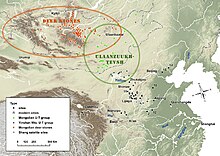 | |
| Geographical range | Mongolia |
|---|---|
| Period | Bronze Age, Iron Age |
| Dates | 1450–1000 BC[1] |
| Preceded by | Ancient Northeast Asians |
| Followed by | Slab Grave culture |
The Ulaanzuukh culture, also Ulaanzuukh-Tevsh culture (Ch:乌兰朱和文化, c. 1450-1000 BCE),[1] is an archaeological culture of the Late Bronze Age eastern Mongolia. It likely preceded and was the origin of the Slab-grave culture.[2]
- ^ a b Honeychurch, William (2015). Inner Asia and the Spatial Politics of Empire: Archaeology, Mobility, and Culture Contact (PDF). p. 112. doi:10.1007/978-1-4939-1815-7. ISBN 978-1-4939-1814-0.
- ^ Lee 2023, "“SlabGrave” was representative of people in eastern and central Mongolia associated with Slab Grave (ca. 1000 to 300 BCE) mortuary sites. Likely arising out of the LBA Ulaanzuukh archaeological culture (ca. 1450 to 1150 BCE) in eastern Mongolia, Slab Grave groups expanded into central and northern Mongolia as far north as the Lake Baikal region. Overall, individuals from the Ulaanzuukh and the Slab Grave cultures present a homogeneous genetic profile that has deep roots in the region and is referred to as Ancient Northeast Asian (ANA). The recent publication of additional genome-wide data for Ulaanzuukh and Slab Grave individuals provided an opportunity to investigate the genetic profile of the Slab Grave individuals across a wider geographical distribution (Fig. 1A) and to refine our genetic modeling of the formation of the Xiongnu more generally. We updated our admixture modeling of Ulaanzuukh and Slab Grave individuals using the qpAdm program.".
© MMXXIII Rich X Search. We shall prevail. All rights reserved. Rich X Search
